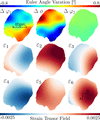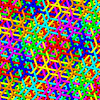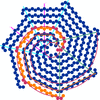issue contents
November 2023 issue

Cover illustration: Small-angle scattering tensor tomography can be used to reconstruct the orientation of nanostructure. In this issue, Nielsen et al. [Acta Cryst. (2023), A79, 515–526] introduce a new reconstruction algorithm and compare it with existing methods using simulations and experimental data. The cover image shows a simulated field of reciprocal-space maps (top left), the main orientation per voxel from the model (top right) and its reconstruction (bottom right), and a volume render of the error between them (bottom left).
advances
research papers


 access
access access
accessfoundations
research papers
 access
access access
access access
access access
accessshort communications
international union of crystallography


 journal menu
journal menu






























